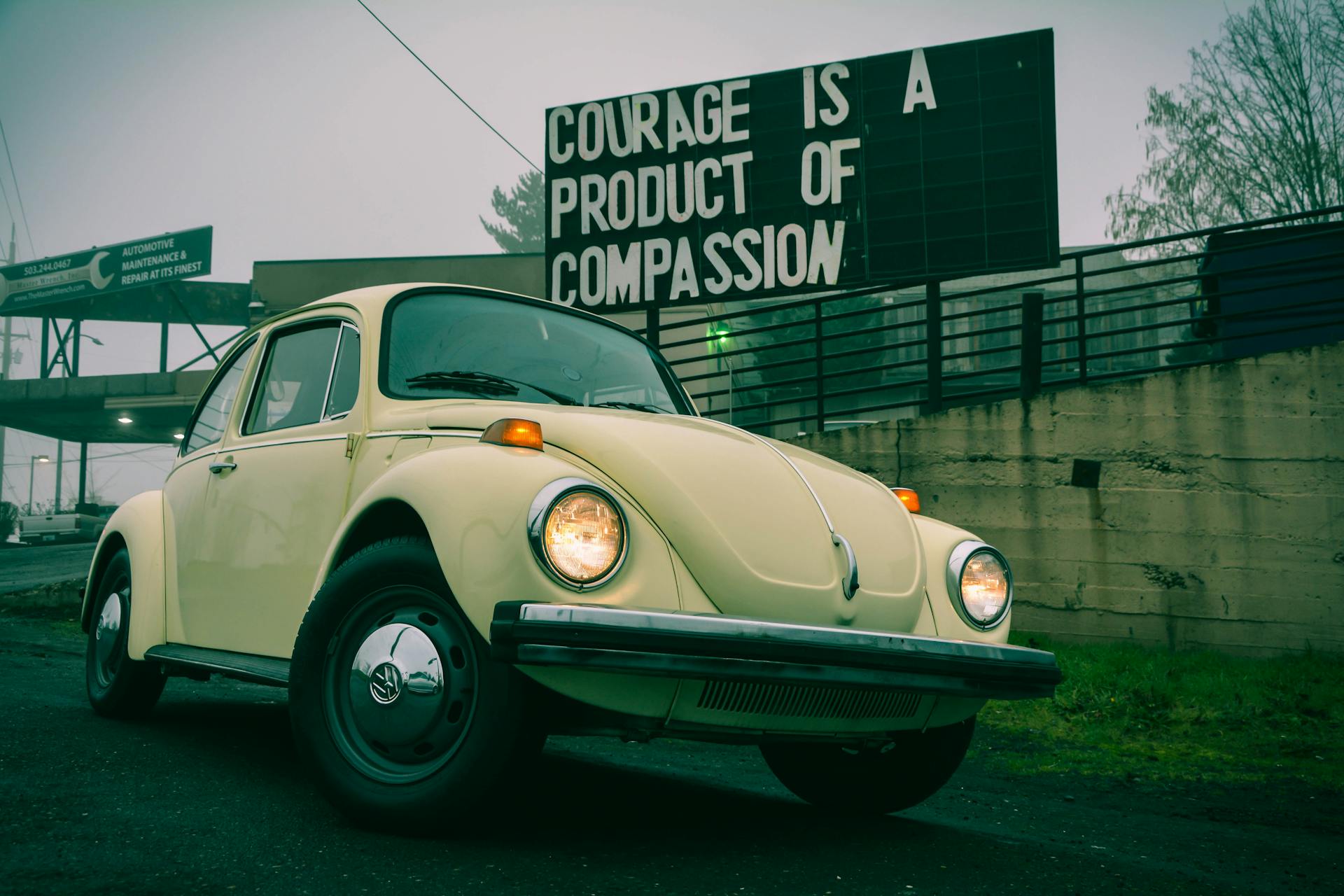
Auto insurance is a vital protection for drivers, but it can be overwhelming to understand what's covered and what's not. Auto insurance typically covers damages to your vehicle, as well as medical expenses for you and your passengers in the event of an accident.
There are several types of auto insurance, including liability, collision, comprehensive, and personal injury protection (PIP). Liability insurance covers damages to others in an accident, while collision insurance covers damages to your vehicle, regardless of who's at fault. Comprehensive insurance covers damages from non-accident events, such as theft or vandalism.
Each state has its own minimum insurance requirements, so it's essential to check your state's specific laws to ensure you have adequate coverage.
What Auto Insurance Covers
Auto insurance can be complex, but understanding what's covered can give you peace of mind on the road.
Bodily injury liability insurance covers the costs of injuries you cause to others in an accident.
Property damage liability insurance pays for damages to other people's property, such as their car or building.
Uninsured motorist coverage and underinsured motorist coverage protect you in case you're involved in an accident with someone who doesn't have insurance or doesn't have enough insurance to cover the damages.
Collision coverage covers damage to your vehicle from a car accident, regardless of who's at fault.
Comprehensive coverage covers a wide range of damages to your vehicle, including theft, vandalism, fire, floods, falling objects, hail, and collisions with animals.
Medical payments (MedPay) and personal injury protection (PIP) cover medical expenses for you and your passengers in case of an accident.
Here's a breakdown of the common car insurance coverage types and what each covers:
Types of Auto Insurance
There's no such thing as "full coverage" in auto insurance - it's an insurance myth. You should choose the coverages that are right for you.
A typical car insurance policy provides multiple types of coverage, which can vary from state to state. These coverages are usually considered standard for most policies.
Your policy will outline how much coverage is provided in each of these coverage categories, as well as any deductible you may have to meet for each category.
Here are the main types of auto insurance coverages:
- Liability coverages
- Vehicle coverages (such as comprehensive and collision)
- Coverages for yourself (such as personal injury protection)
- Other optional coverages
Collision and comprehensive insurance are two separate coverage types that are often sold together. Collision insurance pays to repair or replace your car if you crash into another car or object, while comprehensive insurance pays to repair and replace your car if it is stolen or damaged by fire, flooding, hail, vandalism, or other external factors.
Collision
Collision coverage is a type of auto insurance that pays for damage to your car resulting from a collision with another car, an object, or as a result of flipping over.
It also covers damage caused by potholes. Collision coverage is generally sold with a separate deductible, which means you'll have to pay that amount out of pocket before your insurance kicks in.
If you're not at fault for the accident, your insurance company may try to recover the amount they paid you from the other driver's insurance company.
Here are some examples of what collision coverage pays for:
- Damage to your car from a collision with another car or object
- Damage caused by potholes
Keep in mind that even if you're at fault for the accident, your collision coverage will reimburse you for the costs of repairing your car, minus the deductible.
Uninsured/Underinsured Motorist
Uninsured motorist coverage reimburses you for injuries or property damage caused by a driver without insurance. It also offers protection in the event of a hit-and-run or if you're struck by an uninsured or underinsured motorist.
This type of coverage pays for medical bills, lost wages, pain and suffering, funeral expenses, and injuries if you're hit as a pedestrian by an uninsured driver. The coverage amount typically matches your liability car insurance amounts.
Here are some key benefits of uninsured motorist coverage:
- Your medical bills from an accident caused by an uninsured driver are covered.
- Your lost wages due to injuries are reimbursed.
- Your pain and suffering is compensated.
- Funeral expenses are covered.
- Your injuries as a pedestrian hit by an uninsured driver are covered.
Underinsured motorist coverage pays your medical bills, lost wages, and other expenses if a driver hits you and they have insufficient liability insurance.
How Much?
To determine how much car insurance you need, a general rule of thumb is to buy enough liability car insurance to cover what you could lose in a lawsuit so you can protect your assets, savings, and house.
At the very least, you want enough liability coverage to pay for a serious accident you cause, such as limits of 100/300/100.
If you want car insurance to pay for repairing or replacing your car if it's stolen or damaged from an accident, fire, severe weather, or striking an animal, you'll want to add collision and comprehensive insurance.
If you need even more coverage, look at optional coverage like gap insurance and rental reimbursement coverage.
Additional Coverage Options
Additional coverage options can be a lifesaver in unexpected situations. Emergency Road Service is one such option that provides roadside assistance, including towing services.
If your vehicle breaks down, Rental Reimbursement insurance can cover the cost of a rental car. This can be a huge relief, especially if you're not near a major city or have other transportation commitments.
Here are some additional coverage options to consider:
- Gap insurance pays the difference between the insurance check and the amount owed on your loan or lease.
- Rental Reimbursement insurance covers rental car or public transportation costs if your car is in the shop.
- Roadside assistance insurance provides services such as towing, fixing a flat tire, refueling, and jump-starting a dead battery.
- Rideshare insurance fills the gap where personal auto insurance ends and your rideshare company's insurance begins.
Accident forgiveness is another option that can protect your rates from increasing after an accident.
Medical Payments or PIP
Medical Payments or PIP is a type of coverage that pays for the treatment of injuries to the driver and passengers of the policyholder's car.
This coverage can cover a wide range of expenses, including medical payments, lost wages, and the cost of replacing services normally performed by someone injured in an auto accident.
Medical Payments coverage, often referred to as "MedPay", covers medical expenses for you and your passengers regardless of who is at fault for the accident. It's often sold in small amounts and is not available in all states.
Personal Injury Protection (PIP) insurance generally covers medical treatment, lost wages, or other accident-related expenses, regardless of who caused the accident.
Here are some key benefits of Medical Payments or PIP coverage:
- May pay medical expenses related to a car accident
- May pay for medical treatment, lost wages, or other accident-related expenses
Comprehensive
Comprehensive insurance covers a wide range of events, including theft, fire, falling objects, and damage caused by animals.
This type of insurance will pay to repair your windshield if it's cracked or shattered, and it's usually sold with a separate deductible, although some insurers may offer the glass portion without one.
Comprehensive insurance is optional in terms of state laws, but if you have a car loan or lease, your lender or leasing company will likely require you to carry it.
Damage caused by natural disasters such as tornadoes, hurricanes, wildfires, earthquakes, and other events will typically be covered as long as you carry comprehensive coverage.
If you hit a deer while driving, it's usually considered an event outside of your control, and comprehensive coverage will likely apply, not collision insurance.
Comprehensive coverage will also pay to repair and replace your car if it's damaged by hail, flooding, or vandalism.
Here are some examples of events that are typically covered by comprehensive insurance:
- Falling objects (such as tree branches)
- Striking animals (such as deer or birds)
- Fire (including wildfires)
- Water and flooding
- Hail
- High winds
- Flying debris
- Lightning strike
Keep in mind that comprehensive insurance only pays out up to the actual cash value of your car, minus your deductible.
Rental
Rental coverage is an important aspect of auto insurance that can provide financial protection in case you need to rent a car due to a breakdown or accident.
If your vehicle breaks down, rental reimbursement insurance can cover the cost of a rental car. This type of insurance is especially useful if you rely on your vehicle for daily activities.
To determine if your insurance policy covers rental cars, check your policy documents or contact your insurance provider. Some policies may have specific exclusions, such as luxury rental cars.
Here are some scenarios where rental coverage may come in handy:
- The cost of a rental car if your vehicle breaks down.
- The cost of a rental car if you're involved in an accident.
If you have a large balance on your car loan and your car's current value is well below your loan balance, consider purchasing gap insurance to cover the difference between the insurance check and the amount owed on your loan.
In addition to rental reimbursement insurance, roadside assistance insurance can provide services such as towing, fixing a flat tire, refueling, and jump-starting a dead battery if you get stranded alongside the road.
Crime
Crime can be a significant concern for homeowners and renters alike. Burglary is a leading cause of property damage and theft.
According to the FBI's Uniform Crime Reporting (UCR) Program, there were an estimated 1.5 million burglaries in the United States in 2020. This is a 7.1% decrease from the previous year.
The average loss per burglary is around $2,500. This can be a significant financial burden for many individuals and families.
Having the right insurance coverage can help mitigate the financial impact of a burglary.
Liability and Injury Coverage
Liability car insurance pays out to others when you cause property damage or injuries to someone else. This can include medical bills, damage to their vehicle, and even legal costs if you're sued.
You'll often see policy limits written as three numbers, such as 20/40/10. This means $20,000 of bodily injury/death coverage for one person per accident, $40,000 of bodily injury/death coverage to more than one person per accident, and $10,000 of property damage coverage per accident.
Having enough liability insurance is crucial, as you could be sued for any amount that exceeds your policy limits. It's recommended to buy more than the state-required minimum liability insurance to protect your assets, such as your home and savings.
Here's a breakdown of the types of liability coverages:
- Bodily Injury liability: pays damages for bodily injury or death resulting from an accident for which you are at fault
- Property Damage liability: pays for damage to someone else's property resulting from an accident for which you are at fault
Liability
Liability insurance is a crucial aspect of car insurance that protects you financially in case you cause an accident and are held liable for damages or injuries to others. Liability insurance pays out to others when you cause property damage or injuries to someone else.
You'll often see liability insurance limits written as three numbers, such as 20/40/10. This means $20,000 of bodily injury/death coverage for one person per accident, $40,000 of bodily injury/death coverage to more than one person per accident, and $10,000 of property damage coverage per accident.
Having enough liability insurance is essential to protect your assets, such as your home and savings, in case you're sued for a large sum of money. It's recommended to buy more than the state-required minimum liability insurance.
Liability car insurance covers your legal costs if you're sued over a car accident. You're required to purchase liability car insurance in most states, and buying more than your state's minimum requirement is a good idea.
Here's a breakdown of the two types of liability coverages:
In some states, you can buy uninsured motorist property damage insurance, but it can have low limits that may not cover the repairs or the total loss of your car.
Tree Falling on You
If a tree falls on and damages your car, comprehensive coverage will likely cover repairs once you've met your deductible.
In some cases, another person may be responsible for covering tree-related repairs to your vehicle, such as if a neighbor's tree falls due to neglect or improper maintenance.
The other party's insurance will likely kick in to cover repairs if a landscaper or tree removal company inadvertently causes the damage.
Injuries
Injuries can be a serious consequence of car accidents, and it's essential to understand how liability and injury coverage can help. Liability car insurance pays out to others when you cause property damage or injuries to someone else. If you cause an accident and the other driver breaks their arm, your liability insurance would pay for their medical bills and the damage to their vehicle.
Liability insurance also covers your legal costs if you are sued over a car accident. You'll often see the limits written as three numbers, such as 20/40/10. That means $20,000 of bodily injury/death coverage for one person per accident, $40,000 of bodily injury/death coverage to more than one person per accident, and $10,000 of property damage coverage per accident.
Personal injury protection (PIP) pays for medical bills for you and your passengers, no matter who is at fault for the accident. PIP is required in some states, such as Massachusetts and New York, and covers medical expenses, lost wages, and the cost of replacement services for things you can't do because of the accident.
Medical expenses for you and your passengers from a car accident, lost wages, funeral expenses, and survivor benefits are all covered by PIP. If you're involved in a serious accident, you may be sued for a large sum of money, so it's recommended to have enough liability insurance to protect your assets.
Here are some key points to remember about injuries and liability coverage:
- Liability insurance pays out to others when you cause property damage or injuries to someone else.
- PIP pays for medical bills for you and your passengers, no matter who is at fault for the accident.
- Medical expenses, lost wages, and the cost of replacement services are all covered by PIP.
- It's recommended to have enough liability insurance to protect your assets in case of a serious accident.
Frequently Asked Questions
What does full auto coverage include?
Full auto coverage typically includes comprehensive, collision, and liability insurance. This combination of coverages protects drivers from financial loss due to accidents, theft, and other non-collision damages.
What is included in basic coverage?
Basic coverage includes liability protection for damage to others and their property, covering medical bills, property repairs, and legal costs. It's a fundamental layer of protection that meets minimum state requirements for drivers.
What is the most basic car coverage?
The most basic car coverage typically includes liability protection, which is often required by law in most states. This coverage helps protect you financially in case of an accident.
Sources
- https://www.iii.org/article/what-covered-basic-auto-insurance-policy
- https://www.geico.com/information/aboutinsurance/auto/
- https://www.nerdwallet.com/article/insurance/what-does-car-insurance-cover
- https://matic.com/what-does-auto-insurance-cover/
- https://www.forbes.com/advisor/car-insurance/what-does-car-insurance-cover/
Featured Images: pexels.com


